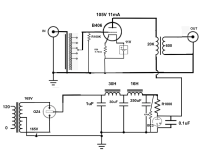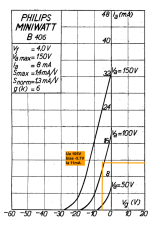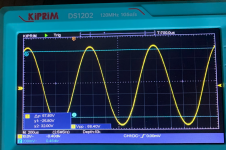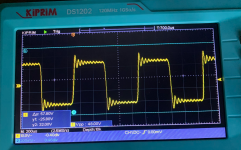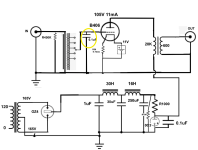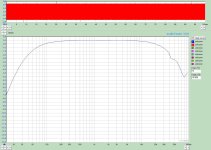My top priority for this design is "simplicity". Fewest parts. Best parts. Avoid Caps and resistors where possible. Iron and tubes. Avoid filament transformers where possible, thus the crazy cold cathode rectifier. The B406 is a Philips tube (European). I selected it because of the 3 factors: a) low mu b) low plate resistance. c) low filament current. I am using 9V 10AH batteries for the filaments. The filaments draw 0.1A, so the batteries should last about 70 hrs between charging. I will play around with bias methods: battery vs. filament vs. RC vs. SIC. Prior experience tells me that, with the proper resistor quality, filament bias is the most natural sound (at least to my ears in my system). YMMV. any input is always welcome. Happy to try new ideas.
I hope your system is sympathetically balanced towards those Feastrex finemet beasts. Mine was not.
In what way did they disappoint?I hope your system is sympathetically balanced towards those Feastrex finemet beasts. Mine was not.
The finemets from Noguchi were extremely fast and hyperdetailed sounding, exaggerating leading edges and ultimately very tiring. I wished they would break in and relax a bit but they never did. Also had a pair of their finemet output transformers, which for a while impressed me with bass, dynamics and speed. Ultimately, a similar, not particularly musical signature. No doubt there is a system somewhere which can accommodate their sonic idiosyncrasies with its own but i prefer using parts with less obvious sonic character. The two wrongs making a right concept in audio has never worked for me.
As for comparisons, a few custom amorphous transformers, several Tangos on both steel and permalloy, some classic UTCs on very large permalloy cores and a whole lot of Lundahls. They all had different strengths and weaknesses but unlike the Noguchi/Feastrex were easy to accommodate without a complete revoicing of the system.
I wish i could say "just my opinion" but a friend went through a very similar experience later on.
As for comparisons, a few custom amorphous transformers, several Tangos on both steel and permalloy, some classic UTCs on very large permalloy cores and a whole lot of Lundahls. They all had different strengths and weaknesses but unlike the Noguchi/Feastrex were easy to accommodate without a complete revoicing of the system.
I wish i could say "just my opinion" but a friend went through a very similar experience later on.
Thanks analog_sa. Its' only a couple days of use for me. Here is what I have noticed so far. 1) very dynamic and clean transients. Are they hyper / false leading edges? TBD. 2) soundstage is great, improved. 3) I am missing the body and earthiness of real music. I should note that this pre-amp is currently using V-Cap capacitors in the power supply. Not sure, yet, how much of this sound is attributable to the V-Caps or the Finemets. I will be replacing the V-Caps with Duelund and KY40 russians to see how the sound changes. My power supply (PT, Chokes) are from Muse Coils, which are state of the art, in my opinion/experience.
Also, I am curious to learn how a different rectifier and bias scheme (battery vs. filemanet vs. RC vs. SIC) will change the sound. Lots of fun stuff. I will report back.
Any thoughts on a great sounding full-wave tube rectifier?
Also, I am curious to learn how a different rectifier and bias scheme (battery vs. filemanet vs. RC vs. SIC) will change the sound. Lots of fun stuff. I will report back.
Any thoughts on a great sounding full-wave tube rectifier?
Using boutique capacitors (V-Cap, Duelund) in PSU (probably 0.68uF, because the other capacitors -due to large values- is horrible expensive things) is wasting money and possibility. These capacitors are very excellent in signal chain (I extensively use copper folie teflon V-Caps), it's a shame to waste them.
BTW K40Y is very good coupling capacitor (I use its), but not in a league with other two.
The PSU's first capacitor selection criterium is voltage, ripple tolerance, ESR, loss, not "tonality".
The most critical capacitor in PSU is the last one. Its charge storage capacity, dynamic impedance, "quick responsibility" significantly determines the amplifier behaviour.
If I designing (for myself!) tube PSU, the last capacitor usually high voltage Elna Cerafine or Black Gate.... although my supplies are slowly running out.
BTW K40Y is very good coupling capacitor (I use its), but not in a league with other two.
The PSU's first capacitor selection criterium is voltage, ripple tolerance, ESR, loss, not "tonality".
The most critical capacitor in PSU is the last one. Its charge storage capacity, dynamic impedance, "quick responsibility" significantly determines the amplifier behaviour.
If I designing (for myself!) tube PSU, the last capacitor usually high voltage Elna Cerafine or Black Gate.... although my supplies are slowly running out.
The boutique caps are used in C1 and bypass of C3. So, in theory, bypass of C3 (1uF) should be audibly noticeable.
Bela, any thoughts on rectifiers in lieu of the cold cathode rectifier? What do you think about an 82 or 80?
Bela, any thoughts on rectifiers in lieu of the cold cathode rectifier? What do you think about an 82 or 80?
80 is the "generic" -for me a little boring- rectifier, 82 is mercury vapour ... many people dislike this .. I use MV rectifiers, but it's not easy to use.
For such -relatively- low current I usually use mesh anode AZ1 rectifiers.
These tubes are more "refined" than other -medium current- metal anode ones.
For such -relatively- low current I usually use mesh anode AZ1 rectifiers.
These tubes are more "refined" than other -medium current- metal anode ones.
Hi everyone, the pre-amp is up and running. I do have a couple of follow-up question.
1. My primary input sources is a 2Vrms streamer. So, what is the ideal bias voltage for the B406? Note, the max current for the B406 is 15mA due to the limits of the L1 and L2 chokes. On the attached tube load lines, I have identified (in orange) the existing operating point. Not sure if -5.7V bias is to hot or cold. Thoughts?
2. How is C3 bleeder resistor value calculated? Is there a formulae.
Thanks
1. My primary input sources is a 2Vrms streamer. So, what is the ideal bias voltage for the B406? Note, the max current for the B406 is 15mA due to the limits of the L1 and L2 chokes. On the attached tube load lines, I have identified (in orange) the existing operating point. Not sure if -5.7V bias is to hot or cold. Thoughts?
2. How is C3 bleeder resistor value calculated? Is there a formulae.
Thanks
Attachments
Just took a couple of scope measurements at the pre-amp RCA output jacks. The Vpp is 6.8V output. Output is maximum on the pre-amp. Input is 1K, 0db sine wave from my streamer (2Vrms). The sine wave on the scope looks clean. However, the square wave looks like overshoot or ringing. Is this typical? Thoughts on how to remediate if this is of concern? I am relatively new to scope measurements, so any input would be greatly appreciated.
Attachments
Check the frequency response! You short the audio with such a high value capacitor, resulting in a fast high frequency rolloff.
Well, my challenge is my age. At a certain age, high frequencies are no longer audible. I can hear to about 2-4K.
gerrittube, what other solution could be used to eliminate/tame the overshoot/ringing, besides the capacitor?
gerrittube, what other solution could be used to eliminate/tame the overshoot/ringing, besides the capacitor?
The pre-amp is running and sounds very good. I would like to add a bit of "weight" to the sound. The tonality is rich, but overall the sound is slightly lean. So, any thoughts on changing my output transformer to an RC coupled output? What kind of audible changes would be expected? Might this help with adding some "weight" to the sound with an appropriate output coupling cap?
- Home
- Amplifiers
- Tubes / Valves
- New pre-amp: B405 with BH rectifier
